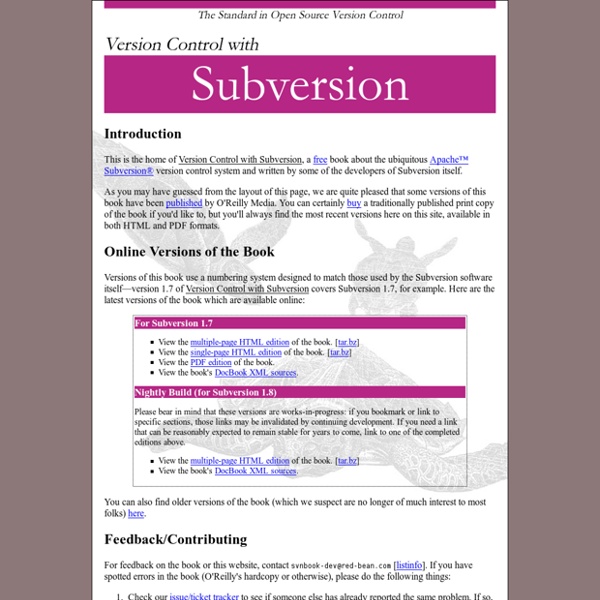Subversion Documentation
Apache Subversion is fortunate to have a community that values documentation. This page contains pointers to varies sources of documentation aimed at Subversion users and developers both of Subversion and of third-party tools with which Subversion integrates. Much of this documentation is itself freely licensed, so if you spot errors in them, please feel free to submit corrections to the relevant owners of the documentation. Subversion User Manuals ¶
Tutorials:How jQuery Works
This is a basic tutorial, designed to help you get started using jQuery. If you don't have a test page setup yet, start by creating the following HTML page: The src attribute in the <script> element must point to a copy of jQuery. Download a copy of jQuery from the Downloading jQuery page and store the jquery.js file in the same directory as your HTML file. Note: When you download jQuery, the file name may contain a version number, e.g., jquery-x.y.z.js.
Blog Archive » Subversion post commit email hook, in Ruby
I’m a big believer in tools. Personally, I believe that better engineers tend to use better tools, but that’s a subject to explore in another post. Here’s a handy Ruby script that sends a descriptive email after each subversion checkin.
How to Prepare Rhino Files for 3D Printing
We recently wrote an overview on How to Prepare CAD Files for 3D Printing, going over some general considerations and steps to properly export your 3D printing files. There are some unique considerations to keep in mind when preparing 3D print files specifically in Rhino, so for this post, we're going to go into more detail on how to export your CAD models here. Let’s dive in! Units and Tolerances Set correct tolerances before you start modelling by finding the tolerance of the program you are exporting your model to and setting Rhino tolerance to be 10 times that (i.e. printer tolerance is 0.1mm, so Rhino tolerance should be set to 0.01mm). Rhino file tolerance can be set from the document properties window, units tab.
Subversion (software)
Apache Subversion (often abbreviated SVN, after the command name svn) is a software versioning and revision control system distributed as free software under the Apache License.[1] Developers use Subversion to maintain current and historical versions of files such as source code, web pages, and documentation. Its goal is to be a mostly compatible successor to the widely used Concurrent Versions System (CVS). The corporate world has also started to adopt Subversion.
Archinteriors vol. 43 for Blender - blend Collection
Free sample This product can be used only for compability testing purposes and familiarization with product line. It cannot be used in any commercial or non-commercial work. download Virtual Cash
A better Subversion post-commit hook than <tt>commit-email
I finally got round to automating sending out commit emails for our Subversion repositories. I tried the supplied post-commit.tmpl and commit-email.pl, but they suck. Six hundred lines of Perl and no effort made to color the patch or format the check-in comment? I knocked up something that isn't going to win any beauty contents unless it's only up against commit-email.pl, in which case it should be a walk-over. Here's the script; as usual, the latest version will be in salma-hayek: #!
Version Control with Subversion
Before jumping into the broader topic of repository administration, let's further define what a repository is. How does it look? How does it feel?
What maps are included and how do I use them? – Quixel
Each material is identically scanned, calibrated and processed and thus follows a consistent standard. The maps are prepared for physically based rendering workflows and calibrated for the Disney “Principled” BRDF. Both Metalness and Specular shader workflows are supported, as well as Roughness and Gloss/Smoothness standards. Maps are provided for both real-time and offline rendering contexts.
Tomorrow Challenge 2019 on Behance
With the hero and panoramic general view, I wanted to show the complete context, just the way it is done in the movies, where there is a general shot that begins by showing the context where the incidents will happen. I used City Engine to recreate the city and some details that were required for the chosen frame, I did this in a procedural way so that it could be a more agile process. It was important that it could be understood that it is Stockholm, the architecture and some buildings that stand out were downloaded from Google Earth. I picked this frame because the Sveavägen street takes you to Stockholm’s downtown and in this way it’s connected to the library.
From Previs to Final Animation
Senior Animator at Encore Elaina Scott studied Character Animation at California Institute of the Arts and graduated with a bachelor's degree in Character Animation. While she was still in school, she got her first job in the animation industry working on The South Park Movie: Bigger, Longer and Uncut.



